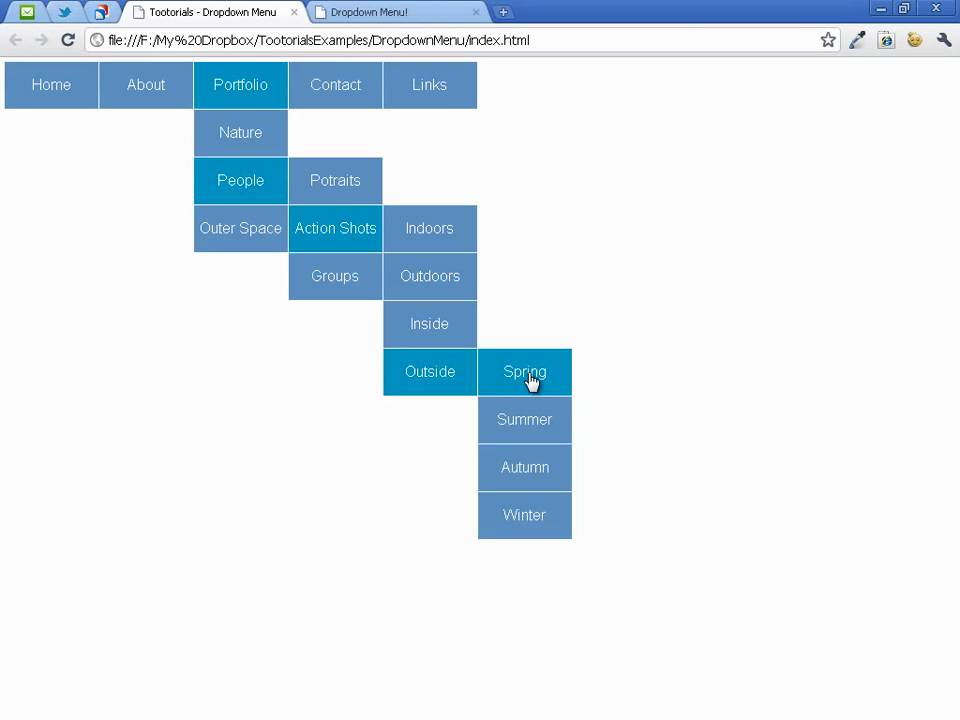Mastering the Dropdown: A Comprehensive Guide to Creating Dropdown Menus in Adobe Dreamweaver

Dropdown menus, those unsung heroes of website navigation, provide a space-saving and intuitive way for users to explore your webpages. In Adobe Dreamweaver, crafting these menus can be achieved through two primary methods: using Dreamweaver’s built-in form menus or diving into the world of HTML and CSS. This guide will equip you with the knowledge to conquer both approaches, empowering you to create dropdown menus that enhance your website’s functionality and user experience.
Method 1: Utilizing Dreamweaver’s Built-in Form Menus (For the Beginner)
While it might not offer the same level of customization as the code-based approach, Dreamweaver’s form menus provide a user-friendly way to create basic dropdown menus. Here’s a step-by-step breakdown:
- Setting the Stage: The Form
- Begin by creating a form element using the Insert menu and navigating to Form > Form. This establishes the container for your dropdown menu.
- Introducing the Menu: The List/Menu Option
- With your cursor positioned within the dotted red border of the form, navigate back to the Insert menu. This time, select Form > List/Menu. This action inserts a dropdown menu element within your form.
- Accessibility Matters: Choosing the Right Menu Type
- A dialog box will appear, prompting you to choose the type of menu. Here’s a quick explanation of the options:
- Pop-up Menu: This classic dropdown menu appears when the user hovers over the menu item.
- Jump Menu: This option redirects the user to a different webpage upon selection.
- A dialog box will appear, prompting you to choose the type of menu. Here’s a quick explanation of the options:
- Customizing the Menu: Properties Panel
- Once you’ve chosen your menu type, the Properties panel comes into play. Here, you can edit the menu’s name (displayed for internal reference) and set the number of visible menu items before a scrollbar appears.
- Populating the Menu: List Values
- To add menu items, click on the menu itself and navigate to the Properties panel. Under the List Values section, you’ll find options to add, edit, or delete menu items. Use the plus sign (+) to add new items, and don’t forget to define the value associated with each item (often the link to a specific webpage).
- The Finishing Touches: Optional Jump Menu Actions
- If you opted for a Jump Menu, you can define the target URL for each menu item within the Properties panel under the Jump Menu Items section.
- Previewing Your Masterpiece
- With everything set up, use Dreamweaver’s Live View feature (or test your webpage in a browser) to see your creation come to life!
Advantages of Dreamweaver’s Built-in Menus:
- Beginner-Friendly: This method offers a visual interface, making it accessible for those new to Dreamweaver.
- Quick and Easy: Creating basic dropdown menus becomes a breeze with this approach.
Disadvantages of Dreamweaver’s Built-in Menus:
- Limited Customization: You have less control over the appearance and behavior of the menu compared to the code-based method.
Method 2: Diving Deeper with HTML and CSS (For More Control)
For those seeking more creative freedom and advanced functionality, venturing into the world of HTML and CSS unlocks a treasure trove of possibilities. Here’s a breakdown of the process:
- Building the Foundation: The HTML Structure
- Begin by creating an unordered list (
<ul>) element within your HTML code. This element will serve as the container for your dropdown menu items.
- Begin by creating an unordered list (
- Introducing the Dropdown Trigger: The Anchor Tag (
<a>)- Inside the unordered list, create an anchor tag (
<a>) element. This element will represent the visible menu button that users will click to trigger the dropdown. Don’t forget to include appropriate text content for the button and style it according to your preferences using CSS.
- Inside the unordered list, create an anchor tag (
- The Hidden Gems: The Nested List (
<li>)- Nest another unordered list (
<ul>) element within the first list item (<li>) created for the menu button. This nested list will contain the actual dropdown menu items that will appear on hover or click.
- Nest another unordered list (
- Creating the Dropdown Items: The Nested Anchor Tags (
<a>)- Within the nested unordered list, create anchor tags (
<a>) for each dropdown menu item. Include the desired text content for each item and define the link (href) attribute to specify the target webpage for each menu item. - The Power of CSS: Styling the Magic
- This is where the true customization magic happens. Using CSS, you can control virtually every aspect of your dropdown menu’s appearance and behavior. Here’s a glimpse into what CSS can achieve:
- Visual Appeal: Define styles for the menu button, dropdown items, hover effects, background colors, and borders. You can leverage CSS properties like
font-family,color,background-color, andborderto create a visually stunning menu that complements your website’s overall design. - Positioning and Layout: CSS empowers you to control the positioning of the dropdown menu relative to the menu button. Properties like
position,display,float, andmarginallow you to fine-tune the menu’s placement and ensure it aligns seamlessly with your website’s layout. - Responsiveness: In today’s mobile-first world, responsive design is crucial. CSS media queries enable you to tailor the dropdown menu’s behavior and appearance for different screen sizes, guaranteeing an optimal user experience across devices.
- Advanced Functionality: CSS offers properties like
transitionandanimationto create smooth transitions and subtle animations when the dropdown menu appears or disappears. This can elevate the user experience and make your website feel more polished. - Here’s a basic HTML structure and accompanying CSS code to get you started with a simple dropdown menu:
- HTML:
- HTML
- <ul class=”dropdown”>
- <li>
- <a href=”#”>Menu Button</a>
- <ul class=”dropdown-content”>
- <li><a href=”#”>Dropdown Item 1</a></li>
- <li><a href=”#”>Dropdown Item 2</a></li>
- <li><a href=”#”>Dropdown Item 3</a></li>
- </ul>
- </li>
- </ul>
- Use code with caution.content_copy
- CSS:
- CSS
- .dropdown {
- display: inline-block;
- }
- .dropdown-content {
- display: none;
- position: absolute;
- background-color: #f1f1f1;
- min-width: 160px;
- box-shadow: 0px 8px 16px 0px rgba(0,0,0,0.2);
- z-index: 1;
- }
- .dropdown-content a {
- color: black;
- padding: 12px 16px;
- text-decoration: none;
- display: block;
- }
- .dropdown:hover .dropdown-content {
- display: block;
- }
- Use code with caution.content_copy
- This is just a starting point, and the possibilities are truly endless. By exploring various CSS properties and techniques, you can create dropdown menus that not only enhance navigation but also add a touch of visual flair to your website.
- Advantages of the HTML and CSS Method:
- Extensive Customization: You have complete control over the look, feel, and behavior of your dropdown menu.
- Flexibility: This approach allows you to create complex and unique dropdown menus that cater to your specific needs.
- Responsive Design: CSS empowers you to ensure your menus function flawlessly across various devices.
- Disadvantages of the HTML and CSS Method:
- Steeper Learning Curve: Working with code requires a basic understanding of HTML and CSS.
- Maintenance Considerations: As you add complexity to your menus, maintaining and updating the code can become more involved.
- Ultimately, the choice between Dreamweaver’s built-in menus and the code-based approach depends on your project’s requirements and your comfort level. If you need a simple and quick solution, the built-in menus are a great option. But if you crave creative freedom and advanced functionality, venturing into the world of HTML and CSS is the path to follow. This guide has equipped you with the foundational knowledge to embark on your dropdown menu creation journey in Dreamweaver, whichever method you choose.
- Within the nested unordered list, create anchor tags (







